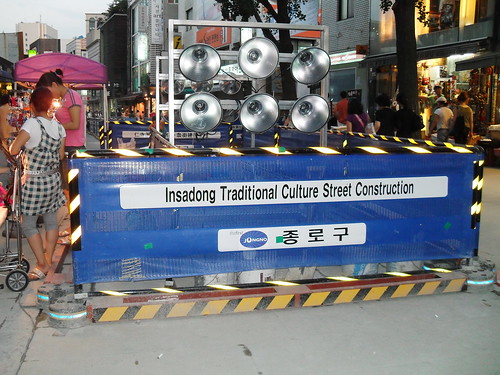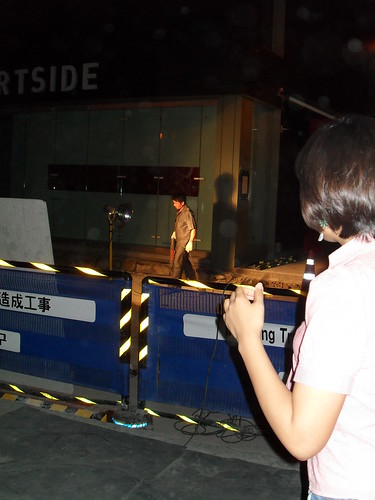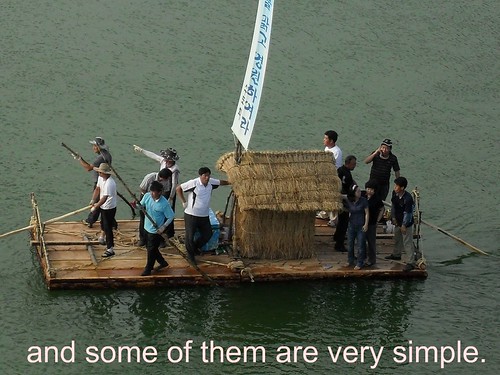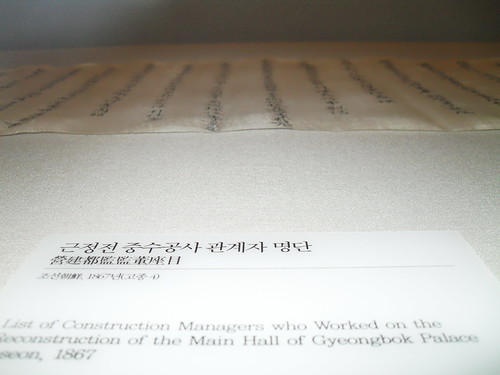
Street and building construction is a deeply spiritual and illustrious cultural custom here in Korea, so we were fascinated to see it in action right there on the street!

Of course, Insadong is a very touristy part of Seoul-- there's a Tourist Information booth right at the entrance to the street. It has little souvenir shops-- oh, not ones with crappy little plastic replicas or anything (at least, not all of them), not THOSE kinds of souvenirs. It's a genuinely nice place to shop, with lots of little crafts stores and art galleries all over the place, and if you're visiting Seoul it's definitely worth a visit. Nevertheless, it's a tourist spot. So Mom and I have the suspicion that in this particular case, the traditional culture street construction is there more as a novelty for tourists to observe than as a genuine expression of the custom. As you can see, some people even gathered around to cheer them on:

So to be honest we kind of wondering if these were actual laborers, or performers, possibly college students majoring in tourism. But either way we enjoyed the demonstration!
Traditional Cultural Construction has actually had far-reaching effects on the religion, values, and economy of South Korea. The practice here is known as "Reconstructionism" and it has become an important aspect of several sects of Korean Buddhism. Here's how it works:
Through the cities and towns of Korea, several buildings are known as Reconstruction Buildings. Some of these are inconsequential buildings, small homes or stores or whatever, while some are very important, such as city halls, opera halls, pretty much halls of all persuasions. Throughout the year, laborers and carpenters erect these establishments, setting the foundations, construction the frames, and so on, with engineers and craftsmen making sure that they are all built to the highest standards. Ideally it should take exactly one year, though for the smaller projects this is not strictly followed.


Then, right before the building is completed-- say there's one more board that needs to be put in place, or one more nail that needs to be hammered in, or one more stripe to be painted on a tiger demanding persimmons of passing maidens-- the building is destroyed!
There's a great celebration surrounding it. I've heard it's an awesome party, but sadly I haven't had the opportunity to experience it myself. I'd have gotten to if I'd stayed in Korea for the whole year, but alas, that's life.
The building demolition can happen in a variety of ways, depending on the type of building, the particular sect of Buddhist Reconstructionism to which the smashers adhere, and the aims of the ceremonial smashing. (Often prayers and requests from the ancestors are involved, particularly in the old days-- it's much like the sacrificial bull, really. Prayers for a plentiful cabbage harvest are common.) Sometimes dynamite is involved. In the grandest and most elaborate destructions, fireworks double as demolition bombs. They both destroy the building, and create very attractive patterns in the sky above! Apparently it's quite a sight to see, with spectators having no idea which way to look!
But of course it's very hard to set up. The juxtaposition of:
1. dynamite
2. fireworks
3. the flying slabs of wood, stone, and painted tiles, the flying components of ondols, known for regularly lighting palaces on fire even without the assistance of bombs, and, in the case of European-influenced construction, flying flying buttresses
and
4. large amounts of spectators who have often already consumed large amounts of soju
combine to make this otherwise awesome spectacle a public safety nightmare. (Although, shockingly, there has been only one known injury resulting from this method, back in 1873 when a 38-year-old cabbage farmer was hit in the head with a flying phoenix sculpture (ironically on fire) and was knocked out. When he awoke, he was convinced that he was a 23-year-old, prodigiously accomplished musician named Stan. Though he actually had no more musical knowledge or talent than one would expect from a 38-year-old cabbage farmer, he made a very comfortable living as a musician, owing to the fact that Koreans from all over the country wanted to see whether or not he had, during this holy ceremony, miraculously learned to play the gayageum. Apparently word of mouth was not a sufficient deterrent, as he had an audience for the rest of his life.)
Since the dynamite variety is dangerous there are other demolition ceremonies. Almost as much fun (so I've heard) are the versions where everyone just grabs a sledgehammer and goes crazy!
The next day, after all the parties on the rubble (as noted above, lots of soju is involved), everyone clears away the debris, and the process begins anew.
Many palaces have a designated hall specifically for this purpose, so that traditional construction is in progress within palace walls all year round. In some palaces, such as Gyeongbuk Palace, the practice is so revered that it is the Main Hall which serves this purpose. At the National Palace Museum of Korea, we saw scrolls preserved that were lists of all the Construction Managers who worked on the Reconstruction of the Main Hall of Gyeongbuk. It was a very honorable position (obviously, or else it wouldn't be immortalized in such a famous museum!).

The idea behind Buddhist Korean Reconstructionism is, I suppose, that the journey is more important than the destination, and that the work itself should be joyful, rather than for material gain. Tibetan monks practice sandpainting (you may have heard of this practice among Native Americans as well), where they create beautiful, intricate designs with sand, and then wipe them out of existence when they are done. As this practice has migrated its way across China, and then down through North Korea, this has evolved from sandpainting to building and street construction-- but the basic philosophy remains the same.
Buddhist Korean Reconstructionism has also been great for the economy, because people always have jobs! Construction and construction-related jobs are extremely easy to get because it's never ending! Carpenters, building contractors, architects-- it's considered a sign of wealth and class if the buildings have a new design each time you build them--painters, roofers, people who construct tiles, people who refurbish the destroyed buildings so that the materials can be recycled... the list goes on and on, and this is a huge fuel for the economy.
North Korea's destitution is largely considered to be due to the fact that they disavowed Reconstructionism when they became communist.
2 comments:
Wow! I can't believe I didn't read this post sooner. This is awesome, and I can't wait to see it. Ahhh! I get to see it! :D
Um. Kat. You didn't... believe me, did you?
Post a Comment